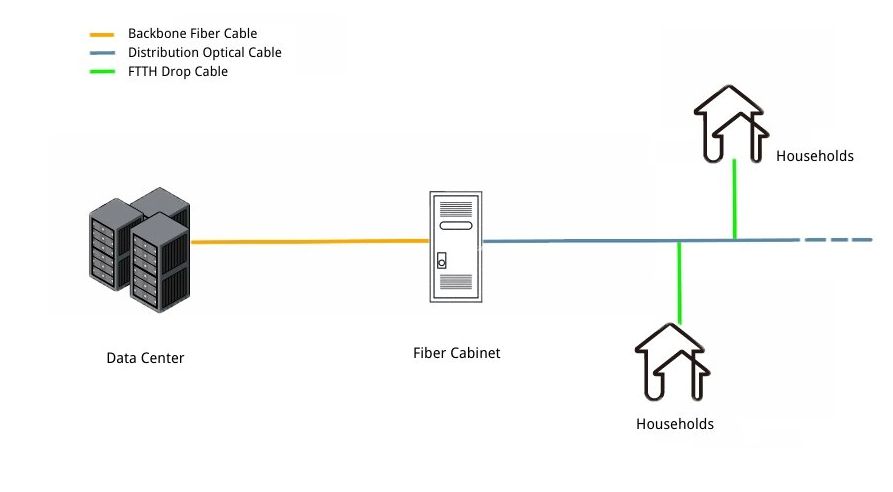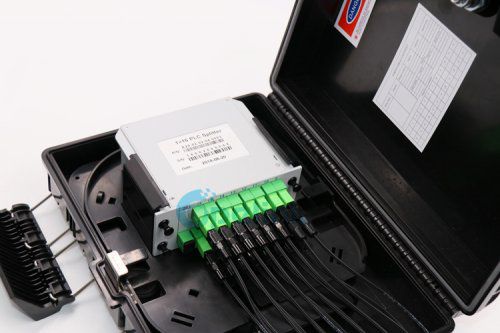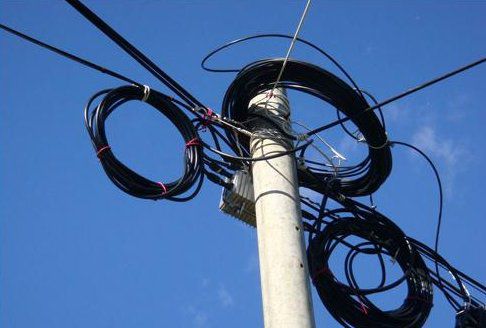Why FTTH Network Is Divided Into Several Sections?
2021-10-26
The fiber optic cable lines used in FTTH network are generally divided into backbone fiber optic cable, distribution fiber optic cable, FTTH drop cable and the access fiber optic cable to user’s home, as shown in below diagram.

Generally speaking, the fewer fiber optic cable sections that a FTTH network passes through, the higher the security of the FTTH network. Then why is the FTTH network is divided into so many sections?
Data Center
If the FTTH network from the data center (or server room) to the user only passes through one optical cable segment (not counting fiber jumpers), that is, each user directly lays a fiber optic cable to the data center, as shown as below. What’s the problem? There are mainly two problems.
Number of incoming fiber optic cables is large, and the number of incoming fiber optic cable that a data center can hold is limited.
Long distance from data center to end user’s home is not convenient for installation, and costs are unimaginable.
Giving the above two aspects, the maximum number of users that can be accessed by such an office is only tens of households, and of course there is no application scenario.
Fiber Distribution Box
In order to solve the above problems, we have made two improvements, as shown in following.
The fiber optic cable comes out of the data center using a large fiber count one, and then split into multiple small fiber count optical cables with fiber splicing joint. Of course, if a fiber optic cable has too many points of splicing, it will affect the life and transmission performance of the optical cable.
Set up a fiber distribution box at a place where users are more concentrated, as the demarcation point between FTTH network and installation. When installing the access fiber network, they will only need to lay a small section of fiber optic cable from the fiber distribution box to the users.
Based on an data center with 10 fiber optic cable, and 6-12 fiber distribution boxes for each fiber cable, and 8 users in each fiber distribution box. It is estimated that the number of users served by a data center is 480 to 960.

At this time, the optical cable line from the data center to the user has become two fiber cable segments: data center – fiber distribution box, fiber distribution box – user. Since the connection of fiber optic cables is fixed at the splicing joint with small attenuation, the splice closure joint box is generally not considered as the starting point of the segmentation.
Compared with the first route map, the number of service users in the central data center has increased several times, but the capacity is still too small. In addition, the dynamic development of users requires flexible installation but not starting a new line from data center.
Fiber Splitting
From the comparison of the above two FTTH network, we can see that from the perspective of reducing the number of outgoing optical cables and facilitating installation, the capacity of the data ceter can be increased by adding branch points on the optical cables. The splicing points of optical cables are mainly achieved by fiber cabinet and splice closure.
One fiber optic cable can be splitted into multiple fiber optic cables through fiber cabinet optical splitting. The number of fiber optic cables that can be divided is mainly limited by the laying conditions of the fiber optic cables. The connection between the fiber optic cables is flexible, but it will increase the active connection loss and increase the difficulty of fiber core management.
The number of optical cables that can be splitted through the splice closure is small, normally no more than 6 (1 in 5 out). Generally, there will be remaining optical cables on both sides of the splice closure. If a splice closure has a large number of different fiber optic cables, the fiber cables will appear messy and unsightly, as shown in following picture. Therefore, in general, the number of fiber optic cables in the splice closure will be controlled within 4 (1 in 3 out).

After adding the fiber cabinet, the FTTH network structure from the data center to the user is shown as below. It is estimated that the number of users served by one fiber cabinet is 480 to 960 by using a fiber cabinet to connect 10 distribution fiber cables, 6 to 12 fiber distribution boxes for each distribution fiber cable, and 8 end users in each fiber distribution box.
So how many fiber cabinet can be set in a FTTH network? Based on the estimation of 10 backbone optical cables outgoing from one data center and 3 fiber cabinets for each backbone optical cable, 30 fiber cabinets can be set.
In this way, the capacity of a data center is approximately 14400-28800. With such a large capacity, FTTH network can basically meet the needs of many scenarios.
Distribution Fiber Cabinet
FTTH network will always be restricted by construction conditions. For example, if the optical fiber cable network is to cover a residential area, it is best to set up the fiber cabinet in the residential area. However, when the backbone optical cable construction of a bureau is carried out, they are allowed to carry out construction in most residential areas. And when the negotiations with a certain residential area for the construction conditions are finally settled, the backbone optical cable has been completed long ago.
The demand for network construction in residential areas, commercial buildings, and other cluster markets in cities is uncertain, and the construction of backbone optical cables must be completed within a certain period of time.
In order to solve this contradiction, during the construction of the backbone fiber optic cable, the fiber cabinet should be placed in a location close to the potential user group, where is convenient for fiber optic cable deployment, and with installation conditions.
When the construction conditions are available in residential areas, commercial buildings, and other cluster markets, install fiber cabinet at these locations, and lay optical fiber cables from the backbone fiber cabinet to distribution cabinet for communication.
In this way, the FTTH network from the data center to end users is divided into the trunk section, the distribution section, the lead-in section and the access section.
The setting of the fiber cabinet can further increase the number of users that the data center can cover. So how many distribution fiber cabinet can be carried under a backbone fiber cabinet? 5 to 10 are suitable. If you only have 2 to 3 fiber cabinets, it is more commercial to use splice closure instead.
Summary
At present, the FTTH network from the data center to end user is mainly a 4-segment structure we covered before. But we should also see that too many segments of the fiber optic cable will make the quality of the FTTH network worse and make the connection more complicated.
The separation of backbone fiber cabinet and distribution fiber cabinet is mainly to solve the problem of different construction timings of backbone optical cables and drop-in optical cables. In scenarios where the construction timing is not affected, such as when the coverage of a FTTH network belongs to the same town or the same residence, it doesn’t make much sense to set up the main fiber cabinet and the distribution cabinet separately.
 Email:info@hanlan-tech.com
Email:info@hanlan-tech.com WhatsApp:0086 18073118925
WhatsApp:0086 18073118925 



